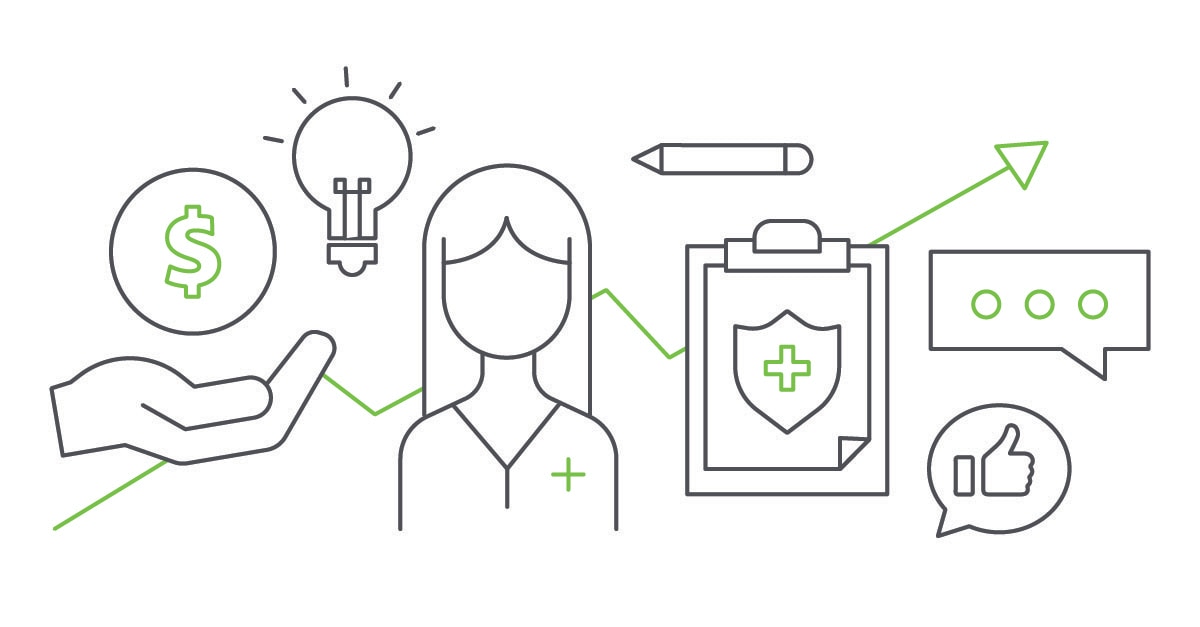5 Key Trends in Healthcare Payments to Watch
With emerging digital solutions and established healthcare payment and financing partners, providers are bridging the gap between what consumers want and need and what providers can offer.
By Ilima Loomis
Digital Writer
Posted Feb 28, 2025 - 7 min read

In today's healthcare environment, patients are increasingly acting as consumers, shopping around for the providers that best meet their needs. While quality of care and the doctor-patient relationship will always be important factors, they're no longer the only considerations for patients making healthcare decisions. Convenience, flexibility and value for money also play a big role in how people choose where to spend their healthcare dollars.
In this article, we'll delve into five trends in how healthcare consumers are paying for care right now — from digital payments to transparent pricing. By understanding what your patients want and need when it comes time to pay, and anticipating their stressors and pain points, you can create a frictionless payment process that improves their overall experience, contributing to patient satisfaction and engagement.
But first, let's look at the larger context of how consumers are paying for healthcare today.
A Focus on Affordability
Rising healthcare costs have always been a concern for patients, but with inflation stretching household budgets further and further, and the price of many medications, tests and procedures continuing to go up, it has never been more important. One recent survey found that only 55% of Americans felt they were able to access and afford quality healthcare when they needed it, a six-point drop from 2022.1 This affordability gap has serious, real-world implications for people's health, as patients may postpone needed procedures or ration prescribed medications due to a concern that they will not be able to pay.
The Rise of Healthcare Consumerism
Providers may not be able to solve inflation or rein in drug costs, but they can address an important pain point for consumers by improving how they make healthcare payments.
A 2023 report found that many consumers had low satisfaction with paying for care, yet they felt that the payment process was of high importance. Addressing these concerns can have significant benefits; the same survey found that satisfied healthcare consumers are less likely to defer care and more likely to pay their medical bills.2
Patients are increasingly shopping around when it comes to choosing a provider. In 2017, between 20% and 30% of healthcare consumers reported researching providers before making an appointment. That number rose to 44% in 2023, according to a recent report. Of those who comparison-shopped, patients considered two to three different providers on average before making a decision. The survey also found that 40% of healthcare consumers prioritize out-of-pocket costs when deciding on a provider.3
What if you could improve the patient experience, increase retention and boost engagement by understanding what each patient wants or needs when it comes time to pay their bill?
Many of the healthcare payment trends we’ll cover in this article focus on the patient’s experience. Today’s patients are empowered healthcare consumers. They comparison shop for prices that fit their budget and search for the best value for their money. Your patients want payment options that make sense for their situation.
5 Healthcare Payment Trends
With that in mind, here are five healthcare payment trends to watch:
1. Healthcare payment flexibility
Today, patients hold a bigger share of payment responsibility than ever before. Consider these statistics:
- More than half (53.6%) of the U.S. private-sector workforce was enrolled in a high deductible health plan (HDHP) in 2022.4
- HDHPs have a deductible of at least $1,650 for an individual or $3,300 for a family in 2025.5
- The annual out-of-pocket maximums for health plans in the Healthcare.gov Health Insurance Marketplace will be $9,200 for singles or $18,400 for families in 2025.6
Everyone deserves access to care but cost may be a barrier. By putting patients' financial concerns at the center of your billing and payment practices, you may improve the patient financial experience. You may also offer a lifeline to patients who might otherwise forgo the care they need without payment options.
2. Digital and online patient payments
Healthcare consumers are comfortable with digital payment options and increasingly prefer the convenience of contactless, cashless payments. According to a 2022 report by the Pew Research Center, 41% of Americans said that in a typical week, they used no cash at all to make their purchases.7
A digital payment platform can help you improve your patients' financial experience by offering multiple payment options, such as credit cards over the phone, online or in-app before their appointment or at the point of care. Meet patients where they are by offering portals for online patient payments, automatic payment services, digital wallets and text-to-pay options.
3. Keeping payments secure
As cashless payments and digital transactions become more common, consumers are expressing concern about their online security. One survey found that around a third of people who used online payment platforms or payment apps said they had little to no confidence that these sites kept their personal financial information secure. Among older adults who avoid payment apps, 58% said they do so because they don't trust them with their money.8
It goes without saying that healthcare providers should provide a high level of data security to protect patients' personal and payment information and make sure that any payment systems are HIPAA and PCI compliant. Only ask for information that is necessary for processing payments (like credit card number, expiration date, CVV code and others) on online payment platforms, and keep this separate from forms that include protected patient information (like diagnoses or treatments). And to reduce the chance of a data breach, use point-to-point encryption for any online transactions.9
4. Healthcare cost transparency
Current laws require hospitals, urgent care and outpatient procedure facilities to publicly disclose what different services cost. However, it's clear that patients want price transparency from their regular healthcare providers as well.
In a 2023 survey by Gallup, fewer than 1 in 5 adults said they knew what their healthcare would cost before they received care. And an overwhelming 95% said they believed that healthcare organizations should be required to inform patients in advance how much a product or service would cost.10
Providers can address this frustration by being up-front and initiating the conversation about cost early, before treatment begins. By being transparent about pricing and discussing options for coverage and financing, clinicians can reduce anxiety for a better patient experience.
5. Value-based care
The same Gallup survey found that patients don't feel they're getting good value for their healthcare spending. Only 29% of adults said that they believe the cost of healthcare products and services reflects the quality of care they receive.10
For many patients, the fee-for-service model is outdated and confusing. It incentivizes billable treatments over outcomes. Increasingly, health and wellness consumers are looking for more value-based, patient-centered care.
Financing Solutions for Your Patients
Consider staying at the forefront of current trends in payments to serve your patients with timely, value-based care. When you consider your patients’ cost concerns and offer them a way to pay in a method that serves them best, you can help increase patient satisfaction and retention.
A Patient Financing Solution for Health and Wellness Providers
If you are looking for a way to connect your patients with flexible financing that empowers them to pay for the care they want and need, consider offering CareCredit as a financing solution. CareCredit allows cardholders to pay for out-of-pocket health and wellness expenses over time while helping enhance the payments process for your practice or business.
When you accept CareCredit, patients can see if they prequalify with no impact to their score, and those who apply, if approved, can take advantage of special financing on qualifying purchases.* Additionally, your practice or business will be paid directly within two business days.
Learn more about the CareCredit credit card as a patient financing solution or start the provider enrollment process by filling out this form.
Author Bio
Ilima Loomis is a freelance writer with more than 18 years of experience in journalism and B2B content marketing. With a background in writing about science and technology, she has a knack for taking on complex subjects and helping readers understand not only what is going on but why it relates to them. She specializes in writing about healthcare, health tech and medical research.
Healthcare payment and financing solution
The CareCredit health and wellness credit card helps improve the payment experience for patients and clients, and your financial performance.
Get Started*Subject to credit approval.
The information, opinions and recommendations expressed in the article are for informational purposes only. Information has been obtained from sources generally believed to be reliable. However, because of the possibility of human or mechanical error by our sources, or any other, Synchrony and any of its affiliates, including CareCredit, (collectively, “Synchrony”) does not provide any warranty as to the accuracy, adequacy, or completeness of any information for its intended purpose or any results obtained from the use of such information. The data presented in the article was current as of the time of writing. Please consult with your individual advisors with respect to any information presented.
© 2025 Synchrony Bank.
Sources:
1 Witters, Dan. "In U.S., affording healthcare more of a struggle since 2022," Gallup. July 17, 2024. Retrieved from: https://news.gallup.com/poll/646994/affording-healthcare-struggle-2022.aspx
2 Buchter, Jessica et al. "Driving growth through consumer centricity in healthcare," McKinsey & Company. March 14, 2023. Retrieved from: https://www.mckinsey.com/industries/healthcare/our-insights/driving-growth-through-consumer-centricity-in-healthcare
3 Buchter, Jessica et al. "Consumers rule: Driving healthcare growth with a consumer-led strategy," McKinsey & Company. April 15, 2024. Retrieved from: https://www.mckinsey.com/industries/healthcare/our-insights/consumers-rule-driving-healthcare-growth-with-a-consumer-led-strategy
4 Hest, Robert and Lanigan, Lindsey. "Exploring cost and coverage rates in employer-sponsored insurance (infographic)," State Health Access Data Assistance Center. September 5, 2023. Retrieved from: https://www.shadac.org/news/cost-cov-ESI-2022
5 "Part III: Administrative, procedural, and miscellaneous," IRS. Accessed February 13, 2025. Retrieved from: https://www.irs.gov/pub/irs-drop/rp-24-25.pdf
6 "Premium adjustment percentage, maximum annual limitation on cost sharing, reduced maximum annual limitation on cost sharing and required contribution percentage for the 2025 benefit year," Centers for Medicare and Medicaid Services. November 15, 2023. Retrieved from: https://www.cms.gov/files/document/2025-papi-parameters-guidance-2023-11-15.pdf
7 Faverio, Michelle. "More Americans are joining the 'cashless' economy," Pew Research Center. October 5, 2022. Retrieved from: https://www.pewresearch.org/short-reads/2022/10/05/more-americans-are-joining-the-cashless-economy/
8 Anderson, Monica. "Payment apps like Venmo and Cash App bring convenience — and security concerns — to some users," Pew Research Center. September 8, 2022. Retrieved from: https://www.pewresearch.org/short-reads/2022/09/08/payment-apps-like-venmo-and-cash-app-bring-convenience-and-security-concerns-to-some-users/
9 "How to secure healthcare payments," The Journal of mHealth. April 30, 2024. Retrieved from: https://thejournalofmhealth.com/how-to-secure-healthcare-payments/
10 Marken, Stephanie. "Few Americans know how much their healthcare costs," Gallup. January 31, 2024. Retrieved from: https://news.gallup.com/poll/609434/few-americans-know-healthcare-costs.aspx




